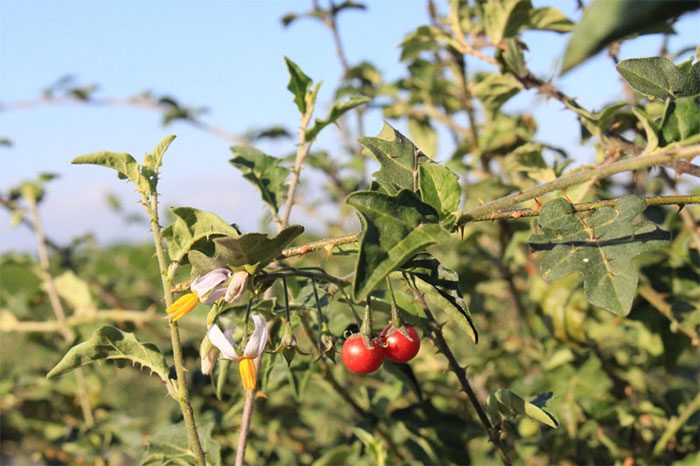Thistle (Cà gai leo) is considered one of the top herbal remedies for treating liver diseases and improving joint health.
A Precious Medicine for Liver Protection
Thistle, known for its liver-protective properties, is a wild plant belonging to the Solanaceae family. In Vietnam, it is referred to by various names, including Cà quýnh, cà quánh, trap khar, cà gai dây, cà vạnh, cà lù, cà bò, cà quạnh, and gai cườm.
Dr. Huỳnh Tấn Vũ, from the University of Medicine and Pharmacy in Ho Chi Minh City – Campus 3, states that thistle is a valuable medicinal herb found widely from low mountains to midland regions and coastal plains. In northern Vietnam, thistle is commonly used as a detox drink for liver health, protecting liver cells.
There are two types of thistle: white-flowered thistle, which has smaller vines and is often used for medicine; and purple-flowered thistle, which has larger vines and is less commonly used due to its weaker pharmacological effects.
Chemical analysis of thistle reveals components such as alkaloids, starch, saponins, solasodine, solasodine, and glycoalkaloids.

Thistle plant. (Illustrative image)
According to traditional medicine, thistle has a warm nature, a slightly toxic taste. Thistle can help disperse wind, relieve rheumatism, detoxify, alleviate coughs, reduce pain, and stop bleeding; it is primarily used for rheumatism, headaches, dry coughs, whooping cough, allergies, cirrhosis, and infections in the oral area. Dosage and usage of thistle: 16g – 20g per day as a decoction. It may be combined with other herbs as prescribed by a doctor.
Dr. Vũ notes that thistle has been used in folk medicine for a long time, dating back to ancient times. The roots and stems of the plant are used to treat weak liver and itching. The ethnic people of the Central Highlands use thistle as a primary herbal remedy for liver ailments. Thistle is particularly effective in cases of jaundice, bloating, fatigue, and indigestion.
Since the 1980s, numerous research studies have been conducted on thistle to clarify its active ingredients, effects, and efficacy in treating liver diseases. Studies have shown that the active ingredients in thistle, especially the glycoalkaloids, can slow the progression of fibrosis and reduce early-stage fibrosis levels.
“The active ingredients in thistle extracts are very effective in treating liver diseases. These ingredients protect the liver. Moreover, they help limit liver cell destruction and quickly lower liver enzymes,” Dr. Vũ said.
In the research conducted by Dr. Nguyễn Thị Bích Thu and colleagues on thistle, it was published that the total extract from the thistle plant and glycoalkaloids exhibit significant antioxidant effects of 47.5% and 38.1%, respectively.
According to Dr. Vũ, there is substantial evidence that thistle supports the treatment of hepatitis, prevents the progression of cirrhosis, lowers liver enzymes, detoxifies, and effectively protects the liver. However, when using thistle as a liver-protecting medicine, it is essential to consider:
- The source of the medicine must be thoroughly checked for quality and origin…
- Thistle can be confused with other plants like deadly nightshade or wild nightshade, especially by those without expertise or after the medicinal materials have been processed…
Therefore, when buying or self-harvesting thistle for medicinal use, individuals need to pay attention to these two points to avoid poisoning, which could further burden the liver and exacerbate conditions. If using thistle as a medicine, consultation with a qualified practitioner is advised.
Below, Dr. Vũ shares some traditional remedies that utilize thistle:
- For rheumatism: 20g thistle, 20g bird foot root, 20g pain vine root, 20g horsetail root, 20g wild yam vine, 20g rose hip root. Boil all ingredients together and consume throughout the day.
- For rheumatic pain, soreness, and back pain: 10g thistle, 10g earthworm, 10g velvet grass, 10g blood-stopping vine, 10g pepper leaf. Combine all ingredients in one decoction and drink throughout the day. Continuous use for one month will show improvement.
Thistle is a small plant with spreading branches covered with star-shaped hair and many thorns. The leaves are green, alternate, oval, or elongated. The underside of the leaves has soft star-shaped hairs, is white but not rough. The upper side of the leaves has thorns.
The flowers of thistle are white with yellow stamens. Each flower has 4 to 6 petals. The berries are glossy, round, green when unripe, and turn red when ripe, with a long stem of about 2cm. The seeds of thistle are yellow and kidney-shaped. Thistle flowers from April to May.
- Research reveals compounds abundant in green tea that help lower blood sugar, preventing diabetes after just one month of use
- This autumn fruit is dubbed the ‘fruit of the gods’ due to its 10 wonderful health benefits
- Inside jackfruit lies something extremely beneficial for the colon, enhancing libido but often discarded



















































